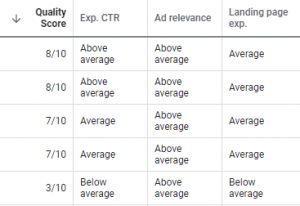This month we take a more detailed look at how to improve Quality Score in Google Ads (as a follow-on to our previous one on ‘Google Ads Bid Levels – Improvement Through Quality Scores and Rank‘). Quality Score works by acting as a general guide for whether or not an advertiser’s ads are relevant and useful. The higher the Quality Score, the more relevant and useful an ad is perceived to be by Google.
 Quality Score is a key metric in Google Ads and one that needs to be reviewed and action taken when necessary. It’s a rating that looks at the overall relevance of keywords, ads, the landing page and landing page experience. It is measured using a scale of 1-10, with 1 being the lowest and 10 being the highest.
Quality Score is a key metric in Google Ads and one that needs to be reviewed and action taken when necessary. It’s a rating that looks at the overall relevance of keywords, ads, the landing page and landing page experience. It is measured using a scale of 1-10, with 1 being the lowest and 10 being the highest.
Quality Score is important because it’s used to identify areas that require optimisation and tells Google how relevant your ad is for the searchers. This way, Google can deliver the best possible experience to searchers and encourage advertisers to make sure that their ads are relevant.
From an advertiser perspective, Quality Score is important because it ultimately determines the success of your Ads account. Quality Score is used to determine Ad Rank, along with your bid level for each keyword. The advertiser with the highest Ad Rank will have the highest ad position on Google.
Advertisers need to deliver relevant ads and offer a good overall user experience, along with their bid, in order to be competitive and achieve a top ranking position for the lowest possible cost per click.
Ad Relevance makes up one of the three key components that determine Quality Score. The other two factors are Expected Click-Through Rate and Landing Page Experience. Each component is rated with either ‘Above average’, ‘Average’ or ‘Below average’.
Ad Relevance
This Google Ads metric measures how closely your keyword matches the message in your ads.
Expected Click-Through Rate (CTR)
Google uses expected CTR to estimate the rate in which people searching for your keywords will click on your ad, based on looking at the past-CTR performance of ads.
Landing Page Experience
Landing page experience refers to how relevant and useful your landing page is, once a user has clicked on an ad. Things to consider here are keyword relevance on the page, as well as your bounce rate and site speed. If bounce rate is high, and/or your landing page takes a long time to load, then Quality Score will suffer.
Seven Ways to Review and Improve Your Quality Score
The first five focus on campaign and ad group structure, ad relevance and generally improving CTR:
1. Campaign, ad group and keyword structure
Make sure your campaigns and adgroups are well structured, particularly with a focus around the main keyword themes being targeted.
2. Write relevant and compelling ad copy
Test your ad copy to make them as relevant and appealing as possible to your target audience. Change the ads with a low CTR to test alternate messages.
3. Ad formats and dynamic headlines
Your ads are the ‘shop front’ for your business to anyone searching for your product or service, and you should test different ads and messages to get the best clickthrough rates to your website.
4. Include as many relevant ad extensions possible
Ensure ad extensions are being used as effectively as possible, in particular sitelinks and callouts.
5. Use negative keywords and review campaigns regularly
The Search Terms report is a good way to review the relevancy of your keyword targeting and to remove search terms that are not targeted for your business or attracting clicks and reducing your CTR.
The final two focus on website content and speed:
6. Work on the landing page;
Landing page experience is a key component of determining the Quality Score, so the message needs to be consistent from keyword to ad and then ad to landing page, with the keywords being present on the landing page and the landing page being consistent with what is being searched for.
The best URL possible should be used for every ad group and those should be relevantly categorised. Also ensure pages with the lowest bounce rates are used and that the website is mobile friendly.
7. Improve site speed
Sites that are quick to load deliver better experiences, are less disruptive and generally lead to better performance and a higher Quality Score.
By improving ad relevance and landing page experience, and achieving a higher CTR, there should be an increase in Ad Rank. This may translate to a lower average CPC and lower costs overall, as well as enabling the campaign to be more competitive and your conversions more cost-effective.
You can find out more on how to track the development of your Quality Score here.
If you want to know how we can help to save you money by having a higher Quality Score, please get in touch. We have been leading Google Ads / AdWords consultants since 2002.
